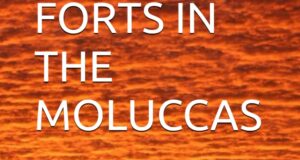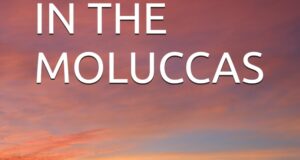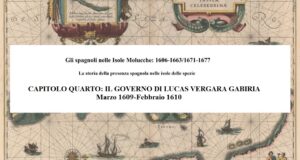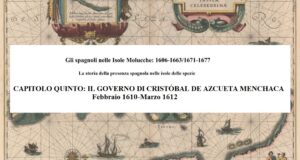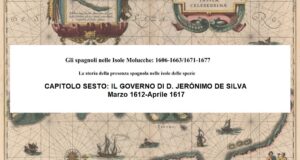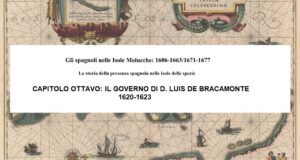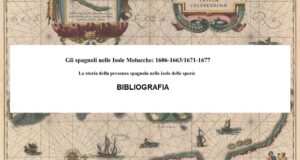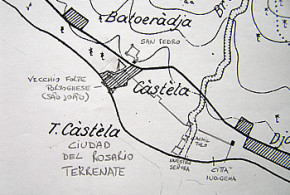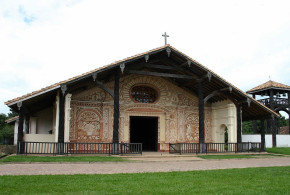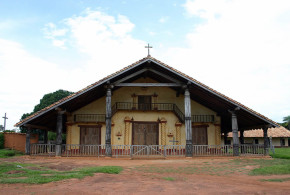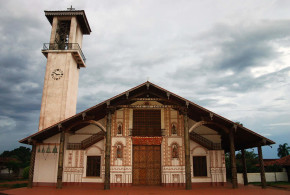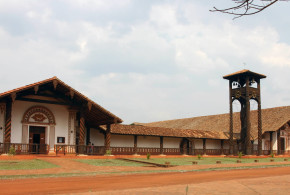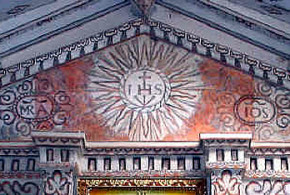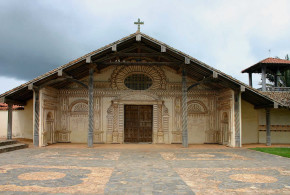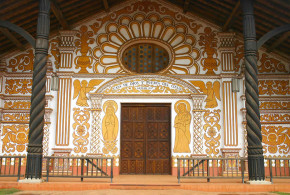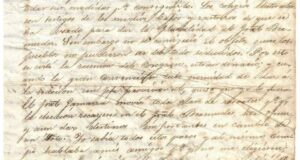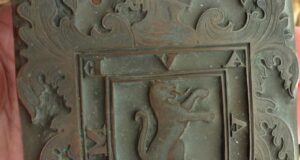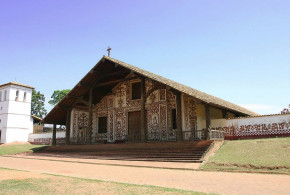This post is also available in:
![]() Italiano
Italiano
Written by Marco Ramerini 2000-2007/2023
5.3 – SANTIAGO DE LOS CABALLEROS (TOHULA)
Tohula1, Santiago de los Caballeros2, Sanctiago de los Caualleros3, Tahula, Taula, Thaula Olandese: Tahoela4, Tahoelo5, Tahoele6: (Current name: Benteng Tohula)
CHRONOLOGY: Spanish: The construction of this fortress was begun by Azcqueta, in 1610, the works were resumed more intensely starting from 1613, it was finished by Geronimo de Silva in 1615, it remained in Spanish hands until 1662 (?)
Other fortification nearby: Fuerte del Principe7, Baluarte del Principe.
The fort of Tahula was the main Spanish fortress on the island of Tidore, it dominated from the top of a hill the city of the king of Tidore and the sea. This was the fort that Acuña had ordered to be built upon his departure, in 1606, and according to his orders, a captain with 50 Spanish soldiers was to reside in this fortress.8
The site chosen for the construction of this new fortress was located very close to the king’s city (‘lugar del Rey‘) and about a quarter of a league from where the old Portuguese fort stood, which caught fire in May 1605 when it was conquered by the Dutch ‘cosa de un quarto de legua de donde antes estaba, la que se boló’. The new fort had to be built on a hill above the sea, the site chosen was in a highly defensible position, because it had two precipices on both sides, while behind it was the volcano, under the fire of the fort’s artillery could repair 2 or 3 galleons. The place chosen was according to the information collected by Juan de Esquivel ‘…en la misma parte que dicen que Hurtado de Mendoça quizo hacerla quando estuvo aquí’. 9
Of this new fort, when Acuña left in May 1606, a plan had been drawn, which unfortunately does not seem to have come down to us. Its construction was placed among the priorities in the orders left by Acuña to Esquivel. In Acuña’s intentions, the fort was to be well equipped with artillery, to defend the galleons that were to anchor in the port, and with a strong garrison commanded by a captain. Its construction had to be carried out as quickly as possible. To do this, an agreement had been made with the king of Tidore, who had undertaken to bring three ‘caracoas‘ with people from the island of Maquien every eight days to work on the fortification.10
But Acuña’s will was not respected, Esquivel informs us that in April 1607, about a year after the conquest of Ternate, he had not yet begun to build the fortress that Acuña had ordered him to build in Tidore, this due to the lack of men with whom to build it and with whom to guard it.11 Furthermore, due to its highly strategic position, its construction was severely hindered in the first years by the Tidorese, who preferred that the Spanish reuse the old Portuguese fort located further away from their city and less dangerously positioned for their interests.
Also some Dutch documents mention this fort or rather the hill on which the fort will later be built: the mountain, which is described in the voyage report of Admiral C. Matalief (1607), round in shape and difficult to access, located at south of the king’s city and on top of which there are Spanish soldiers and three cannons, it is certainly the hill where in the following years the Spaniards will build the fortress of Tahula. While the stone rampart located along the beach and whose walls are as high as a man, and a few musket shots long in the north-south direction, could be the other small defensive post that the Spaniards called the‘baluarte del Principe’.12
Another Dutch report of June 1608 mentions, among other things, also the hill of Tahula (calling it ‘Thahulo‘), where the Spaniards had barricaded themselves and where they had positioned two artillery emplacements, there were probably at least 200 soldiers present in Tidore according to Dutch estimates. The ascent to Tahula Hill must have been very steep as the Dutch saw the Spanish soldiers climb on all fours. The same document also tells us about the fortifications of the city, it was surrounded by a weak wall, but it had a sturdy bulwark of wood and earth on the sea side, this bulwark must have been the embryo of what will later be called the bulwark of the Prince. The Dutch judged this last stronghold quite easy to conquer due to its proximity to the sea. 13
As can be seen from the Spanish and Dutch testimonies, in the first years of their occupation, the Spaniards had evidently limited themselves to placing only a few pieces of artillery and a few troops on the hill of Tahula, without building a real fort, which then, as we shall see, was built only a few years later. In fact, the years of Juan de Esquivel’s government in Ternate (May 1606-March 1609) are characterized by little action and exasperating slowness in the construction and improvement of the works of the fortifications.14
Only after the death of Esquivel, first with the brief government of Lucas de Vergara Gaviria and then with Cristobal de Azcueta, the Spaniards intensified the works for the construction of new fortifications both in Ternate and in Tidore. In particular it was the governor Christobal de Azcueta who during the first months of his government in Ternate, in the year 1610, visited the island of Tidore, where together with his captains he looked for a site where to build the new Spanish fortress.
For this purpose, a hill was chosen which overlooked the whole city of the king, the same one that Pedro de Acuña had identified in 1606. Azcueta asked the king for permission to build a fortress in that place, but during the negotiations, the cachiles of the king of Tidore opposed the Spanish request, saying that if the Spanish had built their own fortress in that place, all of them would have been forced to become Christians and to submit to the Spaniards ‘que en haziendo fuerte alli los spanoles, los auean de hazer atodos hristianos’ ‘les parece a los cachiles y al Rey que donde se haze el fuerte le tenamos el pueblo a cavallero y muy subgeto’.
The cachiles and the king offered the Spanish to build their new fort on the site of the old Portuguese fort, but Azcueta wisely ignored the king of Tidore and his cachiles and declined the offer. Azcueta judged the old fort too far from the king’s city to be able to defend and control it. The firm decision of the Spaniards prevailed over the opposition of the cachiles, and the king finally gave permission for the construction of the fort. The works, Azcueta informs us, began under the direction of Pedro de Avellaneda, who was the leader of the Spanish troops at Tidore. In the paper in which Azcueta informs us of these events, he tells us that together with the letter he also sent a plan of the fort to the governor of the Philippines D. Juan de Silva ‘Embio a Vs.A. con esta aunque no sacada muy en forma la planta del fuerte’. 15 Where this map can be kept today is not known.
Another Dutch report written in 1610 informs us that on a high hill, called Taroula, which overlooks the large city where the king of the island resides, the Spaniards have built a fortification with 10 cannons and a garrison of 50 Spaniards and 8 -10 papangos.16 The Dutch testimony evidently refers to the beginning of the works. The works for the new fort, in 1610, had only been started by the Spaniards, in fact their completion required several more years. The slowness with which the works were carried out, as well as the hostility of the Tidorese, was due to the actual difficulty of transporting the materials and of building such an imposing fortification in such an impervious place.
In conclusion, the works that were never begun during the governments of Juan de Esquivel (May 1606-March 1609) and Lucas de Vergaria Gabiria (March 1609-February 1610), were, as we have seen, started by Azcueta (February 1610-March 1612 ), continued for several years, and were completed, as we shall see, only at the end of 1615 by the next governor Gerónimo de Silva (March 1612-April 1617). In July 1611, the fort of Tidore had six pieces of artillery, of which three were of bronze and the other three of iron ‘colado con sus cuchara y atacadores’.17
Simultaneously with the work on the new fort, the Spanish also improved the defenses located under the hill and which directly affected the city. In all probability it is precisely the ‘baluarte del Principe‘ the fort mentioned by Don Fernando de Ayala in one of his letters, when together with Sergeant Major Balcazar (Esteban de Alcazar) and Don Fernando Becerra in February 1613, he viewed in the city of Tidore the defenses of the fort below ‘… fuerte de abajo …‘ where it was decided to demolish ‘… algunos padrastros que tenia…’.18
At the end of March 1613, the year of greatest Dutch pressure on Tidore, Geronimo de Silva was certainly referring to the fort of Tahula, when he gave the order to put control of the work on the fortification at the top directly into the hands of the king of Tidore ‘… que V. A. acuda á la fortificacion de arriba …‘. These works were judged of capital importance together with those to be done at the ‘fuerte de los portuguéses‘, and which had been entrusted to the supervision of the Prince. In order to speed up the works, de Silva promised the King to immediately send to Tidore all the stonemasons and workers he had at his disposal in Ternate ‘… y ansí irán luego todos los canteros y obreros que aquí tengo, …‘. The governor also ordered to abandon any other fortification work along the shore, referring in all probability to the so-called ‘Baluarte del Principe‘. However, the Prince of Tidore must have already completed his fort, so much so that on April 18, 1613, he arrived in Ternate to request an artillery piece for the bastion he had built.19
A picture of the situation of the Spanish fortifications in the city of Tidore is offered to us by the report left by the English captain John Saris, who visited Tidore in April 1613. The Spanish fort was located on the east coast of Tidore, where it was possible to anchor in deep waters near the coast, at the time of the arrival of the English ship, at anchor under the fort were two Spanish galleys. The British did not stop overnight under the Spanish fort, but being dark they anchored with the assistance of the head of the galleys Gomez about a league and a half away from the fort, where the next morning the British realized they were in the vicinity of a battery of 8 cannons (which was what remained of the Portuguese fort), so they decided to move out of the range of the artillery and anchored a league further south, where they remained for a few days, then upon Spanish request they decided to move to Ternate, to do so they headed south passing again under the Spanish fort, which saluted the British with 5 gun salutes, and then rounded the southern tip of Tidore, where they spotted two Dutch boats anchored near the recently captured Marieco fort.20
The continuous military pressure brought by the Dutch on the Spanish positions in Tidore had the effect of accelerating the works for the construction of the fort which lead the governor de Silva to consider its construction completed in the year 1615. In fact, de Silva speaks to us again of this fortress in a letter dated 12 May 1615, in which he informs the king of Spain that he had built a fortress in Tidore to defend the island from possible Dutch attacks but also from possible coups by the Tidorese, the fortress has three ‘caballeros‘ and 2 ‘baluartes‘.21 In September 1615 the construction work was practically finished in fact de Silva tells us that the new fortress ‘…está ya cerrada y con su puerta y en tan buena defesa…’. 22 With this letter, the governor also sent Don Juan de Silva a ‘pintura‘ of the fortress, unfortunately I was unable to find any trace of this in the archives either. He declares himself particularly proud of having managed to complete this fort even if at the cost of enormous sacrifices.
Subsequent documents indicate the importance given by the Spanish to this fort: this fortress was located on a hill above the ‘Lugar Grande‘ where the king of Tidore had his city and his court (‘…y el dia de hoy está en la forma que he sinificado, bien contra el gusto de los naturales por la carga y freno que tienen en verla sobra si’) and was defined by Gerónimo de Silva, thanks to his ‘…buen sitio y eminencia, caballeros, cortinas y baluartes, algibes y almagacenes…’ as capable of ‘…defenderse por mucho tiempo de todo el poder de Holanda…’ although the artillery present was not much, the fort was judged impregnable ‘…con lo que hay en ella, por muchos dias, habiendo de comer, se puede defender por ser inespugnable, aunque me costó excesivo trabajo por ser la cosa que jamas ninguno de mis antecesorés pudieron acabar, que los moros lo permitiesen ni diesen consentimento a ello…’ although de Silva admits the fortress needs more artillery. From the same letter dated 17 June 1616, it can be deduced that the works for the construction of the fortress had started (or restarted) in 1613: ‘…me fundo en una de cal y canto que he labrado desde su primer cimiento, de tres anos á esta parte…’. De Silva therefore takes all the credit for the construction, even if, as we have seen, the works were started by Azcueta in 1610.23
The fortress of Thaula, is defined as ‘força grande‘, together with it was also a small population (‘cidade pequena‘) where the Portuguese also lived. The fortress ‘he em maneira forte, e inexpugnavel‘ was located ‘muito alta‘ and is ‘toda amurada‘, it had 10 pieces of artillery and a garrison of 40 soldiers commanded by a captain. Near the fortress the Spaniards also had a bulwark called ‘de Principe‘, with three pieces of artillery and where 10 soldiers were stationed with their ensign.24 A confirmation of the fact that this fort was in the immediate vicinity of the Spanish fortress is also given to us in a brief reference to the ‘Fuerte del Principe‘ made by Captain Pedro Martinez Cid, who sent, around 1618, as head the garrison of this fort the ensign Pedro de Mora Salcedo. The fort, Cid informs us, was located ‘tras muro de la fuerza de Tidore’25 Unlike the king’s fort, which was never garrisoned by the Spaniards, the Prince’s fort was garrisoned by Spanish troops, generally it was the ensign of the captain’s company stationed in the fortress of Tidore who commanded the fort, from the documents viewed other names of leaders of the ‘baluarte‘ have come up in addition to that of Pedro de Mora Salcedo (1618). At the head of the ‘baluarte‘ were Pedro de la Fuente Urrozz26 (c.1613/1614), Juan de Medina Bermudez27 (probably before 1618) and Antonio Maldonado y Moscoso28
Some letters29 from Governor Gerónimo de Silva reveal the name by which the Spanish called the fort of Tahula: Forte Santiago, Plaza de Santiago30, Fuerza de Santiago de los Caballeros31 which is evidently the full name by which the fort was called. Further testimony on the name of the fort of Tidore is provided to us in two other Spanish documents, where we are informed that the sergeant major Gonzalo Portillo (who was also governor of the Spanish settlements on the island of Formosa) had the fort of ‘Santiago de los Caballeros de Tidore’32 Finally, Captain Bartholome Alonso was chief (in 1642 or shortly after) of the fort of ‘Sanctiago de los Caualleros de la ysla de Tidore‘. Further on in the same document, we are informed that in 1653-1654, under the government of Francisco de Esteybar, the fortress of ‘Sanctiago de los Caualleros questos en la isla de Tidore‘ was rebuilt and restored.33 Finally, two declarations, one from Captain Gregorio Lopez (captain of the island’s fortresses) signed by the ‘ciudad de Tidore y fuerza de Santiago de los Caualleros, 13 de diciembre de 1617‘ and another from Captain Juan de la Umbria signed ‘en la ciudad de Tidore fuerza de S. Tiago de los Caualleros, 14 de mayo de 1618‘ remove all doubts.34
Around 1659, Alonso del Castillo was appointed head of the fort of the Prince, which was located in the ‘barra‘ of the port of the fortress of Santiago, this bastion was to defend the port of the city.35 The port under the fort of Santiago de los Caballeros was used by the Spaniards as a base for the galleys, which, at least in the intentions of the governor Francisco Suarez de Figueroa, were to serve to attack the Dutch convoys. In fact, the Dutch generally received their relief in Malayo and then subsequently sent some ships to Maquien and Bachan to supply the forts of those islands, Francisco Suarez de Figueroa, planned in September 1640, that in case one or two enemy boats had passed in the vicinity of the fort of Tidore, especially in calm winds, to attack them with the galleys which were anchored in the port of Tidore. It seems that such circumstances, at least on this occasion, did not occur.36
The Spanish commander of the garrisons on the island of Tidore resided in the fortress of Santiago de los Caballeros, who also had jurisdiction over the garrisons of Payaje and Tafongo on the island of Halmahera. It was also in this fortress that the governors of Ternate resided when they were in Tidore.
An interesting document, dated Tidore March 29, 1648, signed by Captain Juan de Zaualeta (Head of the fortress of ‘Sanctiago de los Caualleros de la ysla y reyno de Tidore‘), where Zaualeta himself gives orders to the ensign Miguel de Guinea, who had been appointed head of the garrisons of the island during the absence of Zaualeta who was to go to Ternate at the request of the governor don Lorenzo de Olaso, gives us a small insight into how life went on in the fort of Santiago de los Caballeros of Tidore: The gates of the fort had to remain closed from sunset until 7 in the morning (when the sun was high and the surrounding countryside was visible), furthermore the gates of the fort had to remain closed from noon until two in the afternoon (evidently for the siesta). Every day after the gates of the fort were closed, the Rosary was to be recited. Every day 5 men had to go to the ‘pueblo de los moros’ (i.e. to the city of Tidore) to buy food for the garrison and until they returned it was expressly forbidden for other soldiers to go to the town of Tidore. Particular attention was due to any possible dispute between soldiers and between soldiers and Tidorese who had to be immediately punished, while the most serious crimes had to be reported to the captain who gave the punishments. In case of need to send notices to Ternate, the dispatches had to be sent both by sea and by land, sending them first to the ‘fuerça del Rume‘ so that from there they were sent to Ternate.37
Some other details concerning the life and the dispositions that the Spaniards had to follow in the fort of ‘Santiago de los Caballeros‘, are provided by two other similar documents, the first dated April 13, 1640, in which the governor Francisco Suarez de Figueroa, imparts orders to the new head of the fortress, Captain Ginés Rojas Narvaez. The second is dated 1656 and is signed by the governor Diego Sarria Lascano.
For example, military orders but also penalties for any offenses against God had to be posted in the fort’s guardhouse. Interesting are the orders to be respected in case of a visit to the fort of the king of Tidore. Indeed the king of Tidore was at times in the habit of visiting the head of the fortress, on these occasions only the king could enter the fortress with his arms, if his ‘rregidor‘ was present he could bring his ‘clis‘ (dagger?), the other dignitaries and companions had to leave their weapons at the gate of the fortress. Furthermore, for the entire duration of the visit, the soldiers had to be ready with weapons in hand, especially those in the guardhouse, because, the document informs us, the Tidorese are our friends but we must be careful, because they are always enemies of the our holy faith. If, on the other hand, two or three ‘cayiles‘ or ‘guimalaes‘ visited the fortress, they could bring their weapons into the fortress. Another custom that Francisco Suarez de Figueroa asked to respect in order not to offend the susceptibility of the king of Tidore was the one according to which every 15 days a boat had to be sent to bring the requests of the king of Tidore to Ternate, as was his custom.
The gates of the fort were to be closed from half past five in the evening and by no means opened during the night. During the night it was forbidden to let anyone in or out and the captain had to keep the keys to the fort. Furthermore, communications with Ternate could be made by sea or by the Via del Rume. It was forbidden to fire artillery shells that were not intended against the enemy. Only in the case of the passage of the king of Tidore under the Spanish fortress with his boat was it allowed to fire only one shot with ‘una pieçe suela pequeña‘ which was positioned on the platform, this because by now it had become customary.
In the event of minor disagreements between soldiers, the fort captain was the one to administer the punishments, for the most serious cases the soldiers had to be sent to Ternate, furthermore the sick also had to be sent to be treated in Ternate. Furthermore, it was extremely important to maintain good relations with the ‘cachiles‘, the ‘giumalaes‘ and the important personalities of the island. Finally, from the instructions, we know that a religious was present in the Spanish fort who took care of the spiritual care of the soldiers of the garrison.38
Tahula fort remained under firm Spanish control until nearly the end of the Spanish presence in the Moluccas. It seems that ‘Santiago de los Cavalleros‘ was abandoned between 1661-1662, when the governor of Ternate, Agustin de Cepeda, on the orders of Manrique de Lara, sent the company where Juan de Origuey was ensign to Tidore to withdraw (and demolish) the garrisons of some forts on the island: ‘que asistiese y aiudase a su capitan al rretirar las fuerzas de Tidore, con las de Chobo y otras circumbecinas a los pueblos de los Moros toloas’. According to the testimony of Diego de Salazar, captain of the royal galleys of Ternate, the fortresses that the Spaniards had to demolish and the garrisons they withdrew in 1662 were ‘… me ordeno retirara las de Tidore Chouo, y Puli Cauallo …’ the demolition and withdrawal works were entrusted to the ensign Juan de Origuey, who worked personally managing to transport the artillery and ammunition to Ternate.39 When the Spaniards left, the fort was occupied by the Sultan of Tidore.
Miguel de Pareja, a Jesuit father who visited Ternate and Tidore in 1670, informs us that the ‘nuestra fuerza grande‘ of Tidore had been elected as the residence of the king of the island ‘Saifudin, que vulgarmente llaman Golofino‘ and that in it resided a guardhouse made up of 8-10 Dutch soldiers.40 According to Pastells, Tahula (‘la fuerza grande de esta isla‘) was occupied by ‘Golofino‘ (the king of Tidore Saifudin) to whom the Dutch gave 16 soldiers as a guardhouse.41
According to a Dutch report of 1707, after the departure of the Spanish, the King of Tidore accepted the Dutch request to demolish the forts of Tahoele, Romij and Tiobbe on the promise of 300 Rs.s, but the forts were not completely dismantled and on subsequent King’s request, approved by the company on 19 January 1666, Tahoele fort was retained as a royal residence and was still in fairly good condition in 1707 having been repaired by the recently deceased King Hamza Faharoedin.42
Another mention of the Spanish fort of Tohula is made in a document that is present in the Archivio General de Indias in Seville where there is an interesting correspondence on the Moluccas dated 1778, over one hundred years after the abandonment of the Moluccas by the Spaniards. The correspondence originate from a request made by an envoy of three sultans of the Moluccas (Ternate, Tidore (Taduri) and Bachian) to return under Spanish protection. The envoy of the sultans arrived in Zamboanga in 1778. The envoy brought with him a letter from the sultans of ‘Taduri‘ (Tidore) and Bachan (dated August 1778), as well as a bottle of water from the spring of ‘Torula‘ and a lot of land from the old fort of the Spaniards. From the fact that the two sultans of Tidore and Bachan wrote the document, it seems that in fact only these two sultans were the architects of this initiative. The only result of this embassy was the correspondence in question. 43
The fort is described by De Clercq 44, n 1890 as a small fort called Kota Hula or Tohula. In 1928, van de Wall in his book “De Nederlandsche oudheden in de Molukken” describes Tohula as a fortress located on an almost inaccessible cliff, high on the coast. At that time the fort still showed its five parapets, of which the best preserved was the one located on the sea side. The entrance to the fort was still characterized by a Gothic arch, even the room used as a powder magazine was in a good state of conservation with its stairs. Also visible were large stretches of walls along the perimeter of the fort. The impression that van de Wall made was of a large and important fortification.45
The ruins of the fort are still visible but unfortunately they are described in a state of pitiful abandonment. According to Lonely Planet’s “Indonesia” guide, the ruins of the fort are located above the road at the entrance to Soa Siu, the fort is almost completely engulfed by vegetation.46 Even the Periplus guide “Maluku” makes a small mention of this fort which is described as being in a bad state, it is located on a steep slope just before the entrance to the city of Soa Siu.47 Some recent photos of the remains of the fort walls and the entrance gate of the fortified tower of this fort have been published in the book “Spain and the Moluccas. Galleons around the world”.48
Update: In recent years, the Indonesian government has “restored” the fort in a profound way. The fort today is in an excellent state of conservation and has become a tourist attraction of the island of Tidore.
INDEX:
1 – The Spanish fortresses on the island of Tidore 1521-1663: introduction
3 – The Spanish expeditions to the Moluccas after the union with Portugal
4 – The Spanish forts of the island of Tidore 1606-1663
5 – The defenses of the city of the King of Tidore: Lugar Grande De El Rey (Soa Siu)
6 – Fuerte de los portugueses (Fortaleza dos Reis Magos)
7 – Tohula Fort, Santiago de los Caballeros
8 – Sokanora Fort
9 – Marieco Fort
10 – Tomanira Fort
11 – Chobo Fort
12 – Fort of Rume
13 – Puli Caballo Island
14 – Captains of Tidore (Fortress of Santiago de los Caballeros)
NOTES:
1 Various authors “Correspondencia” 378
2 “Confirmación de encomienda de Abucay, etc Francisco de Esteybar [c] 1661-12-17” AGI: Filipinas,51,N.14
3 “Confirmación de encomienda de Abucay, etc Francisco de Esteybar [c] 1661-12-17” AGI: Filipinas,51,N.14
4 Tiele, P. A. & Heeres, J. E. “Bouwstoffen” vol. II, 379, 382, 383
5 Tiele, P. A. & Heeres, J. E. “Bouwstoffen” vol. II, 381
6 Tiele, P. A. & Heeres, J. E. “Bouwstoffen” vol. III, 399; Various authors “Dagh-Register, anno 1664” 286, 389, 598.
7 “…por las pocas fuerzas que hoy tiene el rey de Tidore, por ser muy solo y no tener en su isla lo que tenia hasta aqui, por lo que me conviene tener siempre en esta isla sobre ducientos hombres en la plaza de Santiago y en el fuerte del Principe, Tomanira y Socanora”. “Tanto de carta que el señor don Gerónimo de Silva escribió á el señor don Juan de Silva, Tidore en 8 de agosto de 1616” In: “Correspondencia” 387-388
8 Argensola, Bartolomé Leonardo de “Conquista de las islas Malucas” 345
9 “Carta de Juan de Esquivel al Rey, Terrenate 02 de mayo 1606” AGI: Patronato,47,R.19 pubblicata anche in: Pastells “Historia general de Filippines” tomo V, ccxxix-ccxxx
Other than this statement by Esquivel, I have found no other evidence regarding Hurtado de Mendoça’s intentions to build a new fortress at Tidore at this spot.
10 “Instrucción a Juan de Esquivel para conservación. Terrenate, 02-11-1606” probably 2 May 1606 AGI: Patronato,47,R.17
11 “Carta de Juan de Esquivel a la Audiencia sobre Terrenate, 04-04-1607” AGI: Filipinas,20,R.1,N.2
12 “Report of the voyage of Admiral C. Matelief, written in 1607” in: Commelin’s “Begin ende voortgangh” Vol. 2, 63
13 “Informatie van den stant van de Molucques, door Jan Bruyn, 12 may 1609” In: “De reis van de vloot van Pieter Willemsz Verhoeff naar Azie, 1607-1612” vol. II, 304
de Booy “De derde reis van de VOC naar Oost-Indië onder het beleid van admiraal Paulus van Caerden uitgezeild in 1606” vol. I, 63-64
14 The new governor of the Philippines, Vivero, received rumors from Ternate of complaints against Esquivel. He was accused of not being the right man to manage the situation of the islands, the judgment expressed by the “oidor” don Juan de la Vega was particularly harsh, he judged Esquivel to be an unsuitable man and of little experience for matters of war, moreover, he judged his conduct towards the rebels too little aggressive and accused him of not having proceeded as due with the fortification works. De la Vega also recalls that Esquivel had also allowed the Dutch to occupy and fortify Malayo without doing anything important to prevent it. AGI 1-2-1/14, ramo 27 e AGI 67-6-20 in: Pastells “Historia general de Filipinas” tomo VI (1608-1618), xl-xli
15 “Cartas del Virrey Luis de Velasco (El Hijo) (1607-1611): 5-El Sargento Mayor Cristóbal de Azcoeta al Gobernador de las Filipinas Don Juan de Silva, sobre le estado de las fuerzas a su cargo. Fuerza de Terrenate, 23-IV-1610” AGI: Mexico, 28, N.2
16 “Journal of Pieter W. Verhoeven, 1610” in: Commelin “Begin ende voortgangh van de Vereenighde Nederlandtsche geoctroyeerde Oost-Indische Compagnie” vol. II, 112
17 “Confirmación de encomienda de Burauen. Expediente de confirmación de la encomienda de Burauen a Bartolomé Díaz Barrera. Resuelto. [f] 18-01-1627” AGI: Filipinas,48,N.13
18 “Carta que escribió el sargento mayor don Fernando de Ayala […] á el señor don Gerónimo de Silva, Tidore, 16 de febrero de 1613” in: Various authors “Correspondencia” 90
19 “Carta que el gobernador don Gerónimo de Silva escribió al rey de Tidore, Terrenate, 31 de marzo de 1613” in: Various authors “Correspondencia” 94
“Carta que escribió el señor don Gerónimo de Silva al señor don Juan de Silva” in: Various authors “Correspondencia” 104
“Carta dirijida á S. M. por don Gerónimo de Silva, Terrenate” in: Various authors “Correspondencia” 125
20 Kerr, Robert “A General History and Collection of Voyages and Travels, Vol. VIII.” Sec. XV. “Eighth Voyage of the English East India Company, in 1611, by Captain John Saris” Sec. 4. “The Voyage of Captain Saris, in the Clove, towards Japan, with Observations respecting the Dutch and Spaniards at the Molucca Islands” e Sec.5. “Further Observations respecting the Moluccas, and the Completion of the Voyage to Japan”
21 “Tanto de carta que el gobernador don Gerónimo de Silva escribió á el rey, nuestro señor, Tidore en 12 de mayo de 1615” in: Various authors “Correspondencia” 284
22 “Tanto de carta que el señor gobernador don Gerónimo de Silva escribió á el señor don Juan de Silva, Terrenate en 9 de setiembre de 1615” In: Various authors “Correspondencia” 310
23 “Tanto de carta que el señor gobernador don Gerónimo de Silva escribió á S.M., Tidore en 17 de junio de 1616” In: “Correspondencia” 368
24 “Relação breve da ilha de Ternate, Tydore…, Malaca, 28 novembre 1619” in: Various authors “Doc. Ultramarina Portuguesa” vol. I, 168
25 See the statement of Captain Pedro Martinez Cid dated March 10, 1620 in: “Confirmación de encomienda de Tulaque, etc Expediente de confirmación de las encomiendas de Tulaque, Mandayat y Buguey en Cagayan a Pedro de Mora. Resuelto, [f] 1639-05-13” AGI: Filipinas,49,N.31
26 He was in charge of the trenches that were made to defend Tidore from enemies. He was also in charge of a fort built by the Prince of Tidore during the period of greatest Dutch pressure. “Informaciones: Pedro de la Fuente Urroz. Informaciones de oficio y parte: Pedro de la Fuente Urroz, capitán, vecino de Manila. Informaciones y poder. [f] 1632” AGI: Filipinas,61,N.12; “Confirmación de encomienda de Agoo. Expediente de confirmación de la encomienda de Agoo en Pangasinan a Pedro de la Fuente Uriez (sic por Urroz). Resuelto. [f] 28-09-1630” AGI: Filipinas,48,N.39
27 “Confirmación de encomienda de Guisan, etc. Expediente de confirmación de las encomiendas de Guisan, Lantac, Adpili, Panglao, Masago, Panaon y Ormoc en Cebu en Leyte a Juan de Medina Bermudez. Resuelto, [f] 12-08-1633” AGI: Filipinas,48,N.67
28 He served for nine years in Ternate, starting in 1612, during these nine years he was also head of the ‘fuerte y fortaleza‘ of the Prince of Tidore. “Confirmación de encomienda de Paracale, etc. Expediente de confirmación de las encomiendas de Paracale y Capalonga en Camarines a Antonio Maldonado y Moscoso. Resuelto, [f] 05-07-1659” AGI: Filipinas,51,N.3
29 See the extract from the letter of Geronimo de Silva to D. Juan de Silva, July 29, 1616 In: Rios Coronel, Hernando de los “Memorial y relacion…” 1621, Madrid, Spain. In: Blair, E. H. e Robertson, J. A. “The Philippine Islands, 1493-1898” vol. 19 (1620-1621), 214
“Tanto de carta que el señor gobernador don Gerónimo de Silva escribió á el señor don Juan de Silva, Tidore 8 de agosto de 1616” in: Various authors “Correspondencia” 388
30 “Tanto de carta que el señor gobernador don Gerónimo de Silva escribió á el señor don Juan de Silva, Tidore 8 de agosto de 1616” in: Various authors “Correspondencia” 388
31 “Tanto de carta que el gobernador don Gerónimo de Silva escribió á el rey de Tidore, Fuerza de Santiago de los Caballeros, en 13 de julio de 1615” in: Various authors “Correspondencia” 297
32 “Respuesta de Gabriel Ruiz en nombre de Corcuera. Manila, 21 de octubre de 1644” AGI: Escribania 409B f. 144v pubblicato in: Borao J. E. “Spaniards in Taiwan” (Taipei, 2002) vol. II, 524
“Nombramiento e instrucciones de Sebastián Hurtado de Corcuera a Gonzalo Portillo, nuevo gobernador de la Isla Hermosa, en nombre del Rey Felipe IV. Se mencionan sus meritos e historia militar. Manila, 13 de abril de 1640” AGI: Escribania 409B f. 153 pubblicato in: : Borao J. E. “Spaniards in Taiwan” vol. I, 311
33 “Confirmación de encomienda de Abucay, etc Francisco de Esteybar [c] 1661-12-17” AGI: Filipinas,51,N.14
34 “Confirmación de encomienda de Guisan, etc. Expediente de confirmación de las encomiendas de Guisan, Lantac, Adpili, Panglao, Masago, Panaon y Ormoc en Cebu en Leyte a Juan de Medina Bermudez. Resuelto, [f] 1633-08-12” AGI: Filipinas,48,N.67
35 “Confirmación de encomienda de Santa Catalina Expediente de confirmación de la encomienda de Santa Catalina en Ilocos a Alonso del Castillo. Resuelto[f] 17-12-1686” AGI: Filipinas,55,N.12
36 “Confirmación de encomienda de Viri. Expediente de confirmación de las encomiendas de Viri en Ibabao (Samar) a Ginés Rojas Narvaez. Resuelto. [f] 09-01-1645” AGI: Filipinas,49,N.61
37 “Confirmación de encomienda de Binalatonga, etc. Expediente de confirmación de las encomiendas de Binalatonga, Bolonguey y Telban en Pangasinan a Miguel de Guinea. Resuelto, [f] 09-12-1655” AGI: Filipinas,50,N.52 order of Juan de Zaualeta (Tidore, March 29, 1648)
38 “Confirmación de encomienda de Viri. Expediente de confirmación de las encomiendas de Viri en Ibabao (Samar) a Ginés Rojas Narvaez. Resuelto. [f] 09-01-1645” AGI: Filipinas,49,N.61
“Confirmación de encomienda de Baratao. Expediente de confirmación de las encomiendas de Baratao en Pangasinan a Alonso Lozano. Resuelto. [f] 16-06-1676” AGI: Filipinas,54,N.12. orders and instructions for the head of the fort of ‘Santiago de los Caualleros‘, signed by Diego Sarria Lascano (Terrenate, 6 June 1656) (sheets 154-165)
39 “Confirmación de encomienda de Majayjay, etc. Expediente de confirmacion de las encomiendas de Majayjay y Santa Cruz en La Laguna de Bay a Juan Rodríguez de Origuey. Resuelto[f]. 08-06-1695” AGI: Filipinas,58,N.3
Memoriale dell’alfiere Juan de Origuey (Manila, 20 settembre 1673) (fogli 18-20) in: “Confirmación de encomienda de Batangas. Expediente de confirmación de la encomienda de Batangas en Balayan a Lorenzo de Zuleta. Resuelto. [f] 03-04-1677” AGI: Filipinas,54,N.14
40 “Fr. Miguel de Pareja to governor Manuel de Leon. Manila, 25 enero 1671” in: Jacobs, “Documenta Malucensia III, 1606-1682” Doc. n° 215, p. 660 e anche nota 6
41 Colin-Pastells “Labor Evangelica” vol. III, 812 note n°1
42 ARA: VOC 8076 Ternate 1707, 429-430
43 “Gobernador Filipinas sobre los tres sultanes de Terrenate” AGI: Estado, 45, N. 5
44 De Clercq F.S.A. “Bijdragen tot de kennis der Residentie Ternate, 1890” (Leiden, 1890) 46
45 Van de Wall, V. I. “De Nederlandsche oudheden in de Molukken” (‘s-Gravenhage, 1928) 267-268
46 Various authors “Indonesia, a travel survival kit” (Hawthorn, 1990) 780
47 Muller , Kal “Maluku: Indonesian Spice Islands” (Singapore, 1997) 115
48 See photos in: Various authors “Spain and the Moluccas. Galleons around the world” (Jakarta, 1992) 64-65
This post is also available in:
![]() Italiano
Italiano
 Colonial Voyage The website dedicated to the Colonial History
Colonial Voyage The website dedicated to the Colonial History


